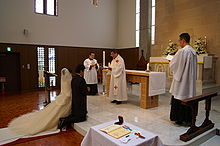Bridal mass

A bridal mass , also called bridal office , is a holy mass in the Catholic Church in which the bride and groom seal their yes to mutual self-giving by uniting themselves with Christ's devotion to his church, and the church wedding is celebrated.
Basic understanding
Christian marriage is a sacrament in the Catholic Church . In the Latin Church it is generally accepted that the bride and groom themselves administer this sacrament to one another by declaring their will to marry before the Church. Because of the inner connection of all sacraments, the wedding is usually celebrated in Holy Mass .
Measurement form
The bridal mass largely corresponds to the celebration of the community mass . According to the Gospel and the homily , the bride and groom publicly declare their will to marry in front of the Church with the assistance of the priest . With the public yes-word in front of the clergyman and the witnesses, the marriage is concluded and the requirements for church recognition of the marriage and its registration in the church register are fulfilled. When the marriage is consummatio , it is indissoluble.
In the bridal mass, the bride and groom often bring the gifts for the preparation of the gifts . They receive communion under both forms .
Alternatives
The wedding ceremony can also take place as part of a liturgical service . In a literal service, the bride and groom marry with the assistance of a priest , deacon or, where there are no priests and deacons, with the permission of the Holy See of an appointed lay person. The presence of two witnesses is always required, but not those of the aforementioned clerics or lay people in exceptional cases.
With the permission of the local ordinary or the parish priest, a marriage can be concluded in another church or chapel instead of in the parish church. With the permission of the local ordinary, it is also possible to get married at another suitable place.
If the prerequisites are met, the marriage can also be justified by a declaration of consent in a non-Catholic church or at the registry office.
Others
The following regulations are possible both in the bridal mass and in the liturgical service:
- To move into the church, the liturgical service (the priest or the deacon with the altar boys ) can greet the bride and groom at the portal of the church and bless the bride and groom by sprinkling holy water .
- The texts of the reading, the Gospel and the sermon relate to the celebration of the wedding. (On liturgical celebrations , however, the liturgical texts of the festival are also prescribed for bridal masses.)
- The sermon is followed by the wedding rite, during which the wedding rings are also blessed. The act of marriage usually ends with a song.
- Then the intercessions are made , the content of which can be tailored to the occasion.
- The blessing is donated to the bride and groom in a solemn form.
The Kart Agen Good Friday and Holy Saturday one is religious marriage excluded; in Lent and Advent it must be kept simple in design because of the penitential nature of the closed times .
See also
Individual evidence
- ^ Catechism of the Catholic Church. 1997, no.1621.
- ^ Catechism of the Catholic Church. 1997, no.1623.
- ↑ Catechism of the Catholic Church, Compendium, para. 343f, 2005, ISBN 3-629-02140-9 .
- ^ Council of Trent, Session XXIV, Decree Tametsi
- ↑ a b CIC , c. 1108.
- ↑ CIC, c. 1112.
- ↑ Catholic Catechism of the Dioceses of Germany: Church wedding without the priest. Herder & Co, Freiburg im Breisgau 1955, p. 186.
- ↑ CIC, c. 1116 § 2
- ↑ CIC c. 118 ( Memento of the original from June 10, 2007 in the Internet Archive ) Info: The archive link was automatically inserted and not yet checked. Please check the original and archive link according to the instructions and then remove this notice.
- ↑ Marriage preparation protocol No. 23 f and note 21 ( Memento from April 18, 2013 in the Internet Archive )
- ^ The celebration of the wedding , 21992, no. 31, Praenotanda no. 32; Pastoral Introduction No. 22